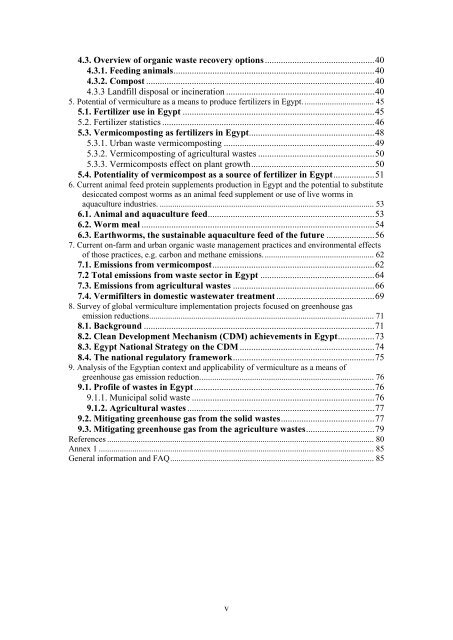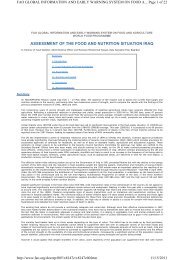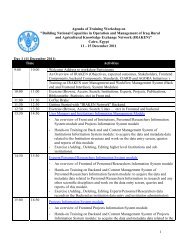Vermiculture in Egypt: - FAO - Regional Office for the Near East and
Vermiculture in Egypt: - FAO - Regional Office for the Near East and
Vermiculture in Egypt: - FAO - Regional Office for the Near East and
Create successful ePaper yourself
Turn your PDF publications into a flip-book with our unique Google optimized e-Paper software.
4.3. Overview of organic waste recovery options ................................................ 40<br />
4.3.1. Feed<strong>in</strong>g animals ........................................................................................ 40<br />
4.3.2. Compost .................................................................................................... 40<br />
4.3.3 L<strong>and</strong>fill disposal or <strong>in</strong>c<strong>in</strong>eration ................................................................. 40<br />
5. Potential of vermiculture as a means to produce fertilizers <strong>in</strong> <strong>Egypt</strong>. ................................. 45<br />
5.1. Fertilizer use <strong>in</strong> <strong>Egypt</strong> .................................................................................... 45<br />
5.2. Fertilizer statistics ............................................................................................. 46<br />
5.3. Vermicompost<strong>in</strong>g as fertilizers <strong>in</strong> <strong>Egypt</strong>....................................................... 48<br />
5.3.1. Urban waste vermicompost<strong>in</strong>g .................................................................. 49<br />
5.3.2. Vermicompost<strong>in</strong>g of agricultural wastes ................................................... 50<br />
5.3.3. Vermicomposts effect on plant growth ...................................................... 50<br />
5.4. Potentiality of vermicompost as a source of fertilizer <strong>in</strong> <strong>Egypt</strong> .................. 51<br />
6. Current animal feed prote<strong>in</strong> supplements production <strong>in</strong> <strong>Egypt</strong> <strong>and</strong> <strong>the</strong> potential to substitute<br />
desiccated compost worms as an animal feed supplement or use of live worms <strong>in</strong><br />
aquaculture <strong>in</strong>dustries. ...................................................................................................... 53<br />
6.1. Animal <strong>and</strong> aquaculture feed ......................................................................... 53<br />
6.2. Worm meal ...................................................................................................... 54<br />
6.3. Earthworms, <strong>the</strong> susta<strong>in</strong>able aquaculture feed of <strong>the</strong> future ..................... 56<br />
7. Current on-farm <strong>and</strong> urban organic waste management practices <strong>and</strong> environmental effects<br />
of those practices, e.g. carbon <strong>and</strong> methane emissions. .................................................... 62<br />
7.1. Emissions from vermicompost ....................................................................... 62<br />
7.2 Total emissions from waste sector <strong>in</strong> <strong>Egypt</strong> .................................................. 64<br />
7.3. Emissions from agricultural wastes .............................................................. 66<br />
7.4. Vermifilters <strong>in</strong> domestic wastewater treatment ........................................... 69<br />
8. Survey of global vermiculture implementation projects focused on greenhouse gas<br />
emission reductions ........................................................................................................... 71<br />
8.1. Background ..................................................................................................... 71<br />
8.2. Clean Development Mechanism (CDM) achievements <strong>in</strong> <strong>Egypt</strong> ................ 73<br />
8.3. <strong>Egypt</strong> National Strategy on <strong>the</strong> CDM ........................................................... 74<br />
8.4. The national regulatory framework .............................................................. 75<br />
9. Analysis of <strong>the</strong> <strong>Egypt</strong>ian context <strong>and</strong> applicability of vermiculture as a means of<br />
greenhouse gas emission reduction. .................................................................................. 76<br />
9.1. Profile of wastes <strong>in</strong> <strong>Egypt</strong> ............................................................................... 76<br />
9.1.1. Municipal solid waste ................................................................................ 76<br />
9.1.2. Agricultural wastes .................................................................................. 77<br />
9.2. Mitigat<strong>in</strong>g greenhouse gas from <strong>the</strong> solid wastes ......................................... 77<br />
9.3. Mitigat<strong>in</strong>g greenhouse gas from <strong>the</strong> agriculture wastes .............................. 79<br />
References ............................................................................................................................... 80<br />
Annex 1 ................................................................................................................................... 85<br />
General <strong>in</strong><strong>for</strong>mation <strong>and</strong> FAQ ................................................................................................. 85<br />
v





